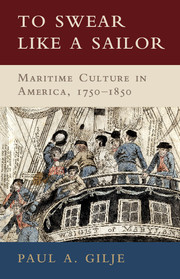Book contents
- Frontmatter
- Dedication
- Contents
- List of Illustrations
- Acknowledgments
- List of Abbreviations
- Introduction
- 1 To Swear Like a Sailor
- 2 The Language of Jack Tar
- 3 The Logbook of Memory
- 4 Spinning Yarns
- 5 Songs of the Sailorman
- 6 The Pirates Own Book
- 7 Tar-Stained Images
- Epilogue: The Sea Chest
- Appendix: A Note on Logbooks and Journals Kept at Sea
- Notes
- Bibliography of Primary Sources
- Index
Appendix: A Note on Logbooks and Journals Kept at Sea
Published online by Cambridge University Press: 05 February 2016
- Frontmatter
- Dedication
- Contents
- List of Illustrations
- Acknowledgments
- List of Abbreviations
- Introduction
- 1 To Swear Like a Sailor
- 2 The Language of Jack Tar
- 3 The Logbook of Memory
- 4 Spinning Yarns
- 5 Songs of the Sailorman
- 6 The Pirates Own Book
- 7 Tar-Stained Images
- Epilogue: The Sea Chest
- Appendix: A Note on Logbooks and Journals Kept at Sea
- Notes
- Bibliography of Primary Sources
- Index
Summary
As explained in the text, the boundary between a logbook and a journal kept at sea was often ambiguous. The notes in this volume therefore use a consistent form of citation regardless of how the logbooks might be catalogued in the different repositories visited during the course of my research. In each case, however, the notes contain enough unique information to lead a subsequent researcher to the same manuscript source.
More than 250 logs of separate sea voyages were examined during the course of the research for this book. Although some of the voyages chronicled appeared within the confines of the same cover, each voyage is listed as a separate log. Research in these logbooks was not random. Instead, using catalog entries, citations by other scholars, and other means, I strove to identify those logbooks which might contain more than the basic wind, wave, and weather routine. I therefore purposefully looked for logbooks that described conflict and contained commentary, poems, songs, illustrations, and other ephemera. I also sought logbooks and journals that reflected different sizes and styles of ships. That said, I read through some more basic logbooks as a control to ensure that I understood the full gamut of what was and was not in a logbook. I was equally concerned with examining logbooks that came from a variety of libraries, that reflected different kinds of ships and voyages, and that were chronologically spread throughout the 1750 to 1850 period. I conducted most of this research over two decades, visiting numerous libraries that contained logbooks, and examined the vast majority of logbooks in manuscript form. Given the nature of my analysis, the ability to physically see and touch these logbooks was essential. I did examine some of the logbooks in microfilm and most recently I have looked at a few logbooks online, thanks to the digitizing of the entire Nicholson Whaling Collection of logbooks at the Providence Public Library and a partial digitization of the logbooks at the G.W. Blunt Library, Mystic Seaport Museum, Mystic, Connecticut.
Examination of the list of the logbooks in the bibliography reveals the following information. The majority of logbooks studied were in five libraries: the Phillips Library at the Peabody Essex Museum (51); the Massachusetts Historical Society (45); G. W. Blunt Library at Mystic Seaport (45); the Providence Public Library (20), and the New Bedford Whaling Museum (18).
- Type
- Chapter
- Information
- To Swear like a SailorMaritime Culture in America, 1750–1850, pp. 274 - 276Publisher: Cambridge University PressPrint publication year: 2016



